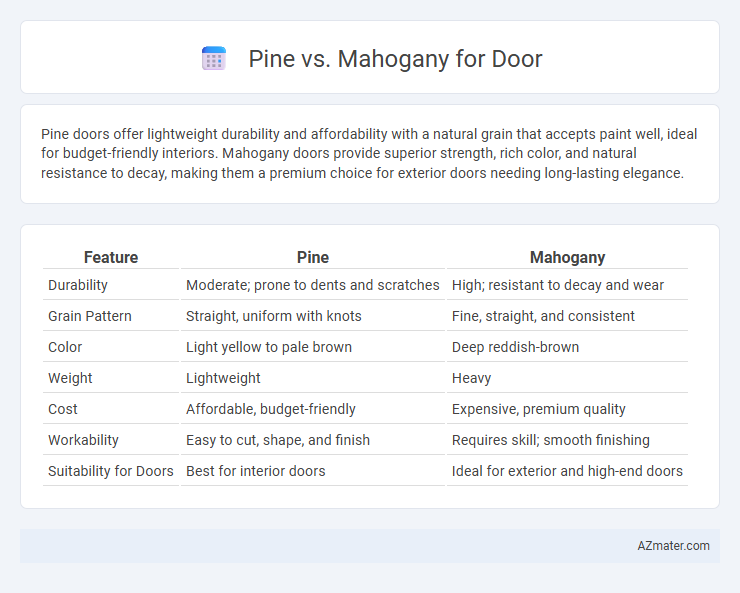Pine doors offer lightweight durability and affordability with a natural grain that accepts paint well, ideal for budget-friendly interiors. Mahogany doors provide superior strength, rich color, and natural resistance to decay, making them a premium choice for exterior doors needing long-lasting elegance.
Table of Comparison
| Feature | Pine | Mahogany |
|---|---|---|
| Durability | Moderate; prone to dents and scratches | High; resistant to decay and wear |
| Grain Pattern | Straight, uniform with knots | Fine, straight, and consistent |
| Color | Light yellow to pale brown | Deep reddish-brown |
| Weight | Lightweight | Heavy |
| Cost | Affordable, budget-friendly | Expensive, premium quality |
| Workability | Easy to cut, shape, and finish | Requires skill; smooth finishing |
| Suitability for Doors | Best for interior doors | Ideal for exterior and high-end doors |
Introduction: Pine vs Mahogany for Doors
Pine and mahogany are popular wood choices for doors, each offering distinct benefits. Pine provides a cost-effective, lightweight option with a natural, rustic appearance, while mahogany delivers superior durability, rich color, and resistance to humidity and pests. Selecting between pine and mahogany depends on budget, aesthetic preference, and the door's intended environment.
Overview of Pine and Mahogany Wood
Pine wood is a softwood known for its light color, affordability, and ease of workability, making it a popular choice for doors where budget and customization are priorities. Mahogany, a hardwood, offers exceptional durability, rich reddish-brown hues, and natural resistance to decay, enhancing the longevity and aesthetic appeal of doors in high-end applications. Both woods provide distinct grain patterns and textures, with pine favoring a rustic or casual look while mahogany suits elegant and formal interiors.
Appearance and Aesthetics Comparison
Pine doors exhibit a light, natural grain with warm, yellowish tones that enhance rustic and casual aesthetics, while mahogany doors feature rich, deep reddish-brown hues and a fine, even grain that exudes luxury and sophistication. Pine's softer texture allows for easy staining and painting, offering versatile design options, whereas mahogany's dense structure delivers a smooth finish with an elegant, high-end appearance. The distinct color richness and grain patterns make mahogany preferable for premium, classic interiors, whereas pine suits more traditional or farmhouse-style doors with its charming and approachable look.
Durability and Strength Differences
Mahogany doors exhibit superior durability and strength compared to pine, making them an ideal choice for exterior applications requiring long-lasting performance. Pine, being a softer wood, is more susceptible to dents and scratches, limiting its durability, especially in high-traffic or weather-exposed areas. The dense grain structure of mahogany provides enhanced resistance to warping and moisture, contributing to its reputation as a robust, premium door material.
Cost and Affordability Analysis
Pine doors are significantly more cost-effective due to their rapid growth rate and widespread availability, making them an affordable option for budget-conscious projects. Mahogany doors, though pricier, offer exceptional durability and luxurious aesthetics that justify the higher investment. Evaluating long-term value, pine provides economic appeal upfront, while mahogany enhances property value through its premium quality and longevity.
Maintenance and Upkeep Requirements
Pine doors require more frequent maintenance due to their porous nature, needing regular sealing or painting to prevent moisture damage and warping. Mahogany doors offer superior durability with natural resistance to rot and insect attacks, reducing the need for frequent upkeep and refinishing. Choosing mahogany minimizes long-term maintenance costs, while pine demands consistent care to maintain its appearance and structural integrity.
Environmental Impact and Sustainability
Pine doors have a lower environmental impact due to their faster growth rate and renewable sourcing, making them a more sustainable choice compared to mahogany. Mahogany, often harvested from slow-growing tropical hardwoods, poses risks to biodiversity and deforestation when not sourced from certified sustainable forests. Opting for FSC-certified pine or reclaimed mahogany can significantly reduce environmental harm while maintaining durability and aesthetic appeal in door construction.
Suitability for Various Door Types
Pine, known for its lightweight and affordability, suits interior doors, closet doors, and decorative panel doors where ease of installation and cost-effectiveness are priorities. Mahogany offers exceptional durability, resistance to moisture, and a rich aesthetic, making it ideal for exterior doors, entryways, and high-traffic areas requiring long-lasting strength and elegant appearance. Both woods can be stained or painted, but mahogany's dense grain provides superior finish quality and weather resistance compared to pine's softer texture.
Pros and Cons of Pine Doors
Pine doors offer affordability, lightweight construction, and ease of customization due to their softwood nature, making them an excellent choice for budget-conscious homeowners seeking a versatile design option. They are prone to dents, scratches, and warping in humid environments, requiring regular maintenance and sealing to enhance durability and prevent moisture damage. While pine provides a warm, natural aesthetic, it lacks the density and hardness of mahogany, which offers superior resistance to wear and a more luxurious appearance.
Pros and Cons of Mahogany Doors
Mahogany doors offer exceptional durability and rich, deep color that enhances home aesthetics and increases property value. They resist warping, decay, and insect damage better than many softwoods, making them ideal for long-term use in varying climates. However, mahogany doors tend to be more expensive and heavier than pine doors, requiring stronger frames and potentially higher installation costs.

Infographic: Pine vs Mahogany for Door
 azmater.com
azmater.com